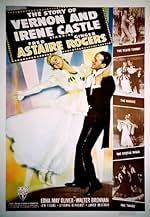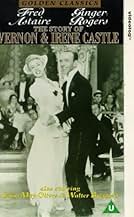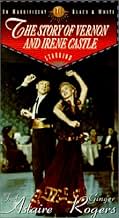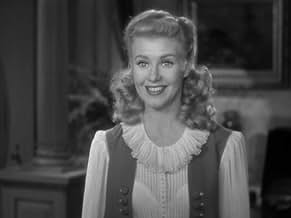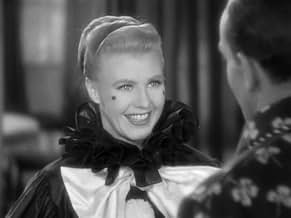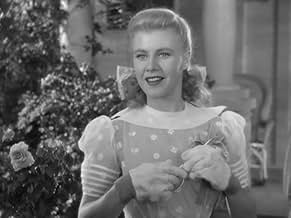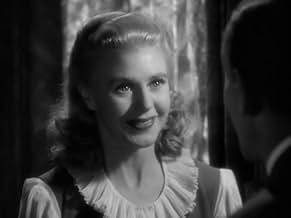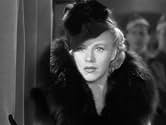VALUTAZIONE IMDb
6,9/10
2895
LA TUA VALUTAZIONE
Aggiungi una trama nella tua linguaThe story of the dancing team who taught the world to two-step.The story of the dancing team who taught the world to two-step.The story of the dancing team who taught the world to two-step.
- Regia
- Sceneggiatura
- Star
- Premi
- 4 vittorie e 1 candidatura in totale
Buzz Barton
- Undetermined Secondary Role
- (non citato nei titoli originali)
Max Barwyn
- Waiter - Cafe de Paris
- (non citato nei titoli originali)
Recensioni in evidenza
Do people watch Astaire and Rogers films for more than the pleasure of their dancing and singing? Both performed the dialog parts in their musical comedies well too, but most people think of their movies as a series of opportunities to see great dance numbers and to hear music by Gershwin, Kern, Berlin, Porter, or Youmans. I doubt if they recall the plots.
"Flying Down To Rio" deals with a traveling orchestra that assists in advertising a hotel in Rio De Janairo. Nobody recalls that, but they recall Youmans' melody "Orchids in the Moonlight" and his dance (for Astaire and Rogers) "The Carioca". They also remember the big production number of the young women on the airplane wing ("Ah, Rio, Rio by the Sea - Oh!"). Except for that, few recall the hero is Gene Raymond and the heroine is Delores Del Rio. The running gag of the three agents of the bank that is trying to sabotage the new hotel (and who are only seen as top hatted shadows) may be recalled - but it isn't really worth recalling.
In the later musicals the same problems exist. The story of "Gay Divorcée" (originally "Gay Divorce" on Broadway) is how Rogers hires Eric Rhodes to be found with her at a resort hotel so her husband can have grounds for divorce. The Porter score including "Night and Day" and "The Continental" was good - but who recalls the plot (though Rhodes is very funny as the perpetual hired "other man" for instant divorces. The final irony of the plot (almost like a flat joke's punch line) is that Eric Blore knows a nasty secret about the husband, who (for his own reasons) does not want a divorce.
The series did try to tie the couple down to more than frivolous plots dealing with mistaken identities or fake personalities. FOLLOW THE FLEET and CAREFREE tried to have plots dealing with sailors putting on a show and with a psychologist falling in love with a patient who was engaged to his best friend (Ralph Bellamy, of course). Both were amusing, but rather slapdash. CAREFREE had a curious concluding moment, when a hypnotized Rogers is literally slapped out of her state of hypnosis. Rogers looks like she has been the victim of domestic violence as she is married.
By 1939 Astaire and Rogers were tired of the series, and wanted to go their separate ways. The public was also getting tired of the series. So finally they were given a property that reversed the formula. Instead of the music and dancing ornamenting a bare plot, the plot incorporated the music and dance by telling the story of the greatest ballroom dance team of the first half of the 20th Century, Vernon and Irene Castle.
I have often felt that had Vernon Castle lived beyond 1917 into the period of talkie movies, and stayed married to Irene, they might have been in some of the Astaire Rogers films (the choreography of two rival couples dancing would have been fascinating). Vernon might have played a mentor or rival or father to Fred. But it wasn't to be. As the film shows Vernon (who was English-born) enlisted in the Air Corps in 1917, and was killed in a freak accident saving the life of a pilot he was training (the scene in the film is quite savage in showing the crash).
In the four years (1913 - 1917) when they swept the world with their mastery of dancing, Vernon and Irene Castle became leading celebrities. The film follows the slow steps to fame they took, including getting stuck for awhile in Paris because Vernon was hired only to be a comic actor, not to be a dancer. It shows how Edna Mae Oliver (as their agent and friend) gets them the breaks they deserve, and how they end as figures of social change (ballroom dancing regained popularity, and they did create not only fashions for men and women but also "the Castle Walk" dance step). That this all happened in four years suggests what their impact would have been if they lived into the 1940s together (Irene Castle died in the 1960s).
There are some delightful moments in the film: Ginger Rogers auditioning for her date Fred Astaire by doing "Yama Yama Man" complete with a costume in her parlor. She is imitating the originator of the song, Bessie McCoy. Walter Brennan trying to protect Rogers from Astaire (whose intentions he constantly suspects). Watch him in a small scene watering the grass of the lawn, and ignoring Astaire's questions. Oliver noticing the rhythmic swaying of the overhead lamp in her apartment due to the dancing going on upstairs (where Fred and Ginger are dancing). But what is best is the feeling of impending doom over the couple. We know Vernon is going to die so that means their success and their life together will end soon.
This sense of doom makes "The Story of Vernon and Irene Castle" unique among the Astaire - Rogers films - it is a downer. There is no getting away from the loss of happiness Irene Castle suffered, nor the loss of talent the theater and dance world suffered. The concluding moment of the film always haunted me - Irene and Vernon dancing in spirit together, twirling in a never-ending, eventually disappearing embrace. When I saw the film the first time, Irene Castle was still alive. The second time she was gone but the two stars were still living. Now Fred and Ginger are gone too. That final ghostly dance manages to encompass two sets of dance legends, and increases the sadness that surrounds this - to me - best of their films.
"Flying Down To Rio" deals with a traveling orchestra that assists in advertising a hotel in Rio De Janairo. Nobody recalls that, but they recall Youmans' melody "Orchids in the Moonlight" and his dance (for Astaire and Rogers) "The Carioca". They also remember the big production number of the young women on the airplane wing ("Ah, Rio, Rio by the Sea - Oh!"). Except for that, few recall the hero is Gene Raymond and the heroine is Delores Del Rio. The running gag of the three agents of the bank that is trying to sabotage the new hotel (and who are only seen as top hatted shadows) may be recalled - but it isn't really worth recalling.
In the later musicals the same problems exist. The story of "Gay Divorcée" (originally "Gay Divorce" on Broadway) is how Rogers hires Eric Rhodes to be found with her at a resort hotel so her husband can have grounds for divorce. The Porter score including "Night and Day" and "The Continental" was good - but who recalls the plot (though Rhodes is very funny as the perpetual hired "other man" for instant divorces. The final irony of the plot (almost like a flat joke's punch line) is that Eric Blore knows a nasty secret about the husband, who (for his own reasons) does not want a divorce.
The series did try to tie the couple down to more than frivolous plots dealing with mistaken identities or fake personalities. FOLLOW THE FLEET and CAREFREE tried to have plots dealing with sailors putting on a show and with a psychologist falling in love with a patient who was engaged to his best friend (Ralph Bellamy, of course). Both were amusing, but rather slapdash. CAREFREE had a curious concluding moment, when a hypnotized Rogers is literally slapped out of her state of hypnosis. Rogers looks like she has been the victim of domestic violence as she is married.
By 1939 Astaire and Rogers were tired of the series, and wanted to go their separate ways. The public was also getting tired of the series. So finally they were given a property that reversed the formula. Instead of the music and dancing ornamenting a bare plot, the plot incorporated the music and dance by telling the story of the greatest ballroom dance team of the first half of the 20th Century, Vernon and Irene Castle.
I have often felt that had Vernon Castle lived beyond 1917 into the period of talkie movies, and stayed married to Irene, they might have been in some of the Astaire Rogers films (the choreography of two rival couples dancing would have been fascinating). Vernon might have played a mentor or rival or father to Fred. But it wasn't to be. As the film shows Vernon (who was English-born) enlisted in the Air Corps in 1917, and was killed in a freak accident saving the life of a pilot he was training (the scene in the film is quite savage in showing the crash).
In the four years (1913 - 1917) when they swept the world with their mastery of dancing, Vernon and Irene Castle became leading celebrities. The film follows the slow steps to fame they took, including getting stuck for awhile in Paris because Vernon was hired only to be a comic actor, not to be a dancer. It shows how Edna Mae Oliver (as their agent and friend) gets them the breaks they deserve, and how they end as figures of social change (ballroom dancing regained popularity, and they did create not only fashions for men and women but also "the Castle Walk" dance step). That this all happened in four years suggests what their impact would have been if they lived into the 1940s together (Irene Castle died in the 1960s).
There are some delightful moments in the film: Ginger Rogers auditioning for her date Fred Astaire by doing "Yama Yama Man" complete with a costume in her parlor. She is imitating the originator of the song, Bessie McCoy. Walter Brennan trying to protect Rogers from Astaire (whose intentions he constantly suspects). Watch him in a small scene watering the grass of the lawn, and ignoring Astaire's questions. Oliver noticing the rhythmic swaying of the overhead lamp in her apartment due to the dancing going on upstairs (where Fred and Ginger are dancing). But what is best is the feeling of impending doom over the couple. We know Vernon is going to die so that means their success and their life together will end soon.
This sense of doom makes "The Story of Vernon and Irene Castle" unique among the Astaire - Rogers films - it is a downer. There is no getting away from the loss of happiness Irene Castle suffered, nor the loss of talent the theater and dance world suffered. The concluding moment of the film always haunted me - Irene and Vernon dancing in spirit together, twirling in a never-ending, eventually disappearing embrace. When I saw the film the first time, Irene Castle was still alive. The second time she was gone but the two stars were still living. Now Fred and Ginger are gone too. That final ghostly dance manages to encompass two sets of dance legends, and increases the sadness that surrounds this - to me - best of their films.
This was the last of the Astaire and Rogers films at RKO (they would reunite at MGM for "The Barkeleys of Broadway" [1949]), and represents the studio attempting to find a new way to make the duo popular. It's hard to believe, since the pair have become legends in Hollywood musical history, but by the end of the 1930s audience interest in Astaire and Rogers seemed to be ebbing. Consequently, this film feels *very* different than the rest of their films.
This is not a story of boy meets girl/boy dances with girl/boy loses girl/boy chases and chases girl/boy gets girl and dances with her again. There aren't a ton of the whimsical oddball comic supporting players. And--steady yourself--there are very few full-out major musical numbers. There is no stunning score of songs by Irving Berlin or the Gershwins.
This is because this is a musical biography about the Astaire and Rogers of the previous generation. Hence, the duo are asked not to dance in the manner that made them popular but in the manner that made *the Castles* popular, and to music that *that* couple danced to. Often, when the two dance, we are interrupted by various plot points (ie., cutting to other characters talking instead of keeping the camera on the dancers). One of the few moments where we are able to enjoy them completely is a montage sequence showing the Castles becoming the toast of the nation (with Astaire and Rogers literally dancing across a giant map of the U.S.)
The other major musical number is a solo: Ginger Rogers singing "The Yama Yama Man." Astaire was about to end his contract at RKO, but Rogers still was under contract--so the studio is plainly more interested in trying to build up Rogers for a solo career, and the film indicates this (Rogers' solo, the emphasis on her clothes and hair, etc.) Meanwhile, the film also indicates a growing awareness of the coming war, by dealing with Vernon Castle's enlistment during World War I--one of the first times Astaire had donned a uniform for the cameras (something he would do a *lot* in musicals for the next 5 years).
All in all, it's not what one usually expects from an Astaire and Rogers film, and thus suffers in comparison to "Top Hat" or "Shall We Dance," but still retains a charm and personality nonetheless.
This is not a story of boy meets girl/boy dances with girl/boy loses girl/boy chases and chases girl/boy gets girl and dances with her again. There aren't a ton of the whimsical oddball comic supporting players. And--steady yourself--there are very few full-out major musical numbers. There is no stunning score of songs by Irving Berlin or the Gershwins.
This is because this is a musical biography about the Astaire and Rogers of the previous generation. Hence, the duo are asked not to dance in the manner that made them popular but in the manner that made *the Castles* popular, and to music that *that* couple danced to. Often, when the two dance, we are interrupted by various plot points (ie., cutting to other characters talking instead of keeping the camera on the dancers). One of the few moments where we are able to enjoy them completely is a montage sequence showing the Castles becoming the toast of the nation (with Astaire and Rogers literally dancing across a giant map of the U.S.)
The other major musical number is a solo: Ginger Rogers singing "The Yama Yama Man." Astaire was about to end his contract at RKO, but Rogers still was under contract--so the studio is plainly more interested in trying to build up Rogers for a solo career, and the film indicates this (Rogers' solo, the emphasis on her clothes and hair, etc.) Meanwhile, the film also indicates a growing awareness of the coming war, by dealing with Vernon Castle's enlistment during World War I--one of the first times Astaire had donned a uniform for the cameras (something he would do a *lot* in musicals for the next 5 years).
All in all, it's not what one usually expects from an Astaire and Rogers film, and thus suffers in comparison to "Top Hat" or "Shall We Dance," but still retains a charm and personality nonetheless.
This bio-pic about the hugely successful dance team, Vernon and Irene Castle, starts at the time of their meeting and covers the entire breadth of their career, starting just before the advent of WWI. This film was released in 1939, so film audiences had plenty of choices and the competition was strong. Still, this ninth pairing of Fred Astaire and Ginger Rogers experienced modest success.
Irene Castle herself was a technical adviser and helped design the gowns that Ginger wore--which, by the way, are very nice, despite Ginger's protestations.
Because this film covers many years and many happenings, it uses montage quite heavily--something that is usually distracting, but in this case it works well.
The dancing documents a variety of styles, some of which were introduced by Vernon and Irene. At the height of their career, they were trendsetters in dance, fashion, culture and taste. Their first dance in the film is an adaptation of minstrel dancing; later dances include the tango and foxtrot. Astaire must have been familiar with all of these styles and probably had used them in his choreography with sister Adele. Still, his choreography in the film is inspired--showing us the essence of each stage in dance evolution.
Ginger is beautiful and she seems to have a freedom in her performance, as if their relationship had advanced to the point of total trust. I only wish this film--and a few of their others--had been shot in color.
Irene Castle herself was a technical adviser and helped design the gowns that Ginger wore--which, by the way, are very nice, despite Ginger's protestations.
Because this film covers many years and many happenings, it uses montage quite heavily--something that is usually distracting, but in this case it works well.
The dancing documents a variety of styles, some of which were introduced by Vernon and Irene. At the height of their career, they were trendsetters in dance, fashion, culture and taste. Their first dance in the film is an adaptation of minstrel dancing; later dances include the tango and foxtrot. Astaire must have been familiar with all of these styles and probably had used them in his choreography with sister Adele. Still, his choreography in the film is inspired--showing us the essence of each stage in dance evolution.
Ginger is beautiful and she seems to have a freedom in her performance, as if their relationship had advanced to the point of total trust. I only wish this film--and a few of their others--had been shot in color.
The Story of Vernon and Irene Castle is the last of the 9 RKO musicals Astaire did with Rogers. However, from a story point-of-view, it is their best film by a mile. The contest isn't even close, IMO.
It's not their best musical. This film is really a drama with a few musical interludes, whereas most of the other Astaire-Rogers films were musical comedies. Those other films had flimsy plots at best and were saved only by their songs and dances. BUT - "Vernon and Irene" could easily stands alone without any songs or dances. It even has some action sequences as is typical of war-time films (WWI, in this case).
The film is a bio-pic about the Castles, who in their heyday were even bigger than Astaire and Rogers. The choreography is more attuned to 1910's sensibilities than the usual Astaire and Rogers film, but that's okay. Astaire and Rogers dance just well as always.
As the dancing duo's last RKO film, V&C is quite classy and a fine close to a great RKO dancing career for the two.
It's not their best musical. This film is really a drama with a few musical interludes, whereas most of the other Astaire-Rogers films were musical comedies. Those other films had flimsy plots at best and were saved only by their songs and dances. BUT - "Vernon and Irene" could easily stands alone without any songs or dances. It even has some action sequences as is typical of war-time films (WWI, in this case).
The film is a bio-pic about the Castles, who in their heyday were even bigger than Astaire and Rogers. The choreography is more attuned to 1910's sensibilities than the usual Astaire and Rogers film, but that's okay. Astaire and Rogers dance just well as always.
As the dancing duo's last RKO film, V&C is quite classy and a fine close to a great RKO dancing career for the two.
There is one hilarious goof in this delightful film. When Irene and Vernon are having dinner in the Parisian restaurant in which they are to make their debut Irene is wearing her wedding dress as they are too broke to afford to buy her a new evening dress, She is also wearing a little lacy winged hat of the type worn in the national costume of Holland.
In England there were gales of laughter when Irene says "I feel just like a bride again in my wedding dress and my little Dutch cap." In the UK a Dutch cap is a female contraceptive device which I believe is called a "diaphragm" in USA.
In England there were gales of laughter when Irene says "I feel just like a bride again in my wedding dress and my little Dutch cap." In the UK a Dutch cap is a female contraceptive device which I believe is called a "diaphragm" in USA.
Lo sapevi?
- QuizIrene Castle served as a technical advisor on the film. According to Ginger Rogers, Castle disliked every costume she wore and deemed them anachronistic. Due to censorship restrictions, Rogers' costumes evoked late 1930s fashions rather than the more daring styles of Castle's 1910s era. After Rogers refused to bob her hair to portray the hairstyle that Irene had popularized, Castle became more displeased. The studio silenced Castle's protests with an additional payment of $5,000.
- BlooperThe film erroneously depicts the Castles touring with white orchestras. In actuality, Vernon and Irene Castle always toured with a black orchestra; specifically, James Reese Europe's Society Orchestra.
- Citazioni
Irene Castle: I thought you could be a first dancer, a very beautiful first dancer because you are a beautiful dancer but you're so smug and conceited that you can't see any further than your funny nose!
- ConnessioniFeatured in Fred Astaire: Puttin' on His Top Hat (1980)
- Colonne sonoreOnly When You're in My Arms
(1939)
by Con Conrad - Herman Ruby Bert Kalmar
Sung by Fred Astaire (uncredited)
End dance: Fred Astaire (uncredited) and Ginger Rogers (uncredited)
I più visti
Accedi per valutare e creare un elenco di titoli salvati per ottenere consigli personalizzati
- How long is The Story of Vernon and Irene Castle?Powered by Alexa
Dettagli
- Data di uscita
- Paese di origine
- Lingua
- Celebre anche come
- The Story of Vernon and Irene Castle
- Luoghi delle riprese
- Azienda produttrice
- Vedi altri crediti dell’azienda su IMDbPro
Botteghino
- Budget
- 1.196.000 USD (previsto)
- Tempo di esecuzione
- 1h 33min(93 min)
- Colore
- Proporzioni
- 1.37 : 1
Contribuisci a questa pagina
Suggerisci una modifica o aggiungi i contenuti mancanti

